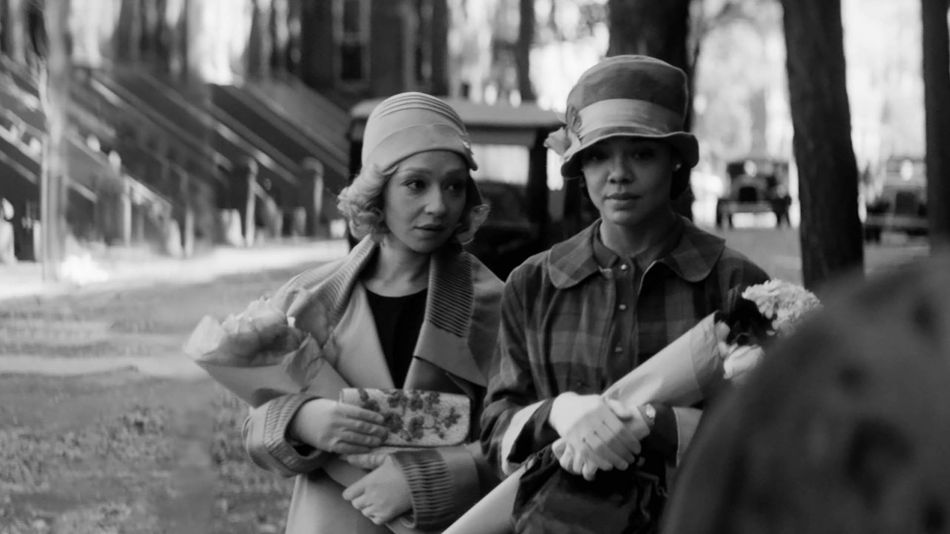
Image: edu Grau / Sundance Institute
It takes a moment for Passing to reveal itself. At first, the screen is just a white blur, and only gradually do shapes and sound begin to emerge: shoes, voices, a street. Eventually, we’re able to place ourselves in 1920s New York, and pinpoint Irene (Tessa Thompson) as our protagonist.
But the disorientation of those first moments never quite fades. Though it’s based on a 1929 novella by Nella Larsen, and shot in the elegant black-and-white and boxy 4:3 aspect ratio of classic Hollywood, Passing feels thoroughly modern in its exploration of the blurred lines demarcating race, class, gender, and sexuality. Its old-fashioned aesthetic becomes another a way of pointing out that though things have changed since then, they haven’t changed as much as we might want to believe.
Irene is a mixed-race woman who’s light-skinned enough to pass for white. It’s an option she rarely exercises — she lives in Harlem with her unmistakably Black husband and sons — but that’s precisely what she’s doing the first time we see her. She stops into a shop frequented by white customers, and then catches a cab to a ritzy whites-only hotel to get away from the sticky summer heat. There she runs into a childhood friend, Claire (Ruth Negga), who’s now passing for white full-time. Even Claire’s husband (Alexander Skarsgard), who casually drops a racist nickname to tease her about her darkening skin, has no idea.
The women’s chance encounter reignites their long-dormant friendship — reluctantly at first on Irene’s part, and maybe too eagerly on Claire’s. Dazzling Claire is moved by a “wild desire” to reconnect with her Black roots and the Black community, and she begins visiting Irene and ingratiating herself into her social circles despite Irene’s frequent reminders that Claire risks blowing her own cover. But Irene doesn’t push back that hard because she’s becoming beguiled by Claire in turn, revealing shades of jealousy and sexual desire to go along with that friendship.
So much of Passing unfolds in the words that aren’t said.
Not that Irene would ever come out and admit it. Thompson has a difficult role to navigate as Irene, a woman in a state of denial even (especially) to herself. But her body gives away what her mind and mouth refuse to let her articulate. We see something telling in the way Irene’s gaze glides over Claire’s leg from across a room, or the grip of her hand on a teapot as she walks toward Claire, or the echo of Claire’s laugh in her memories. So much of Passing unfolds in the words that aren’t said.
That includes the conversations Irene and her husband, Brian (André Holland), avoid about sex or satisfaction or the future of their family. It’s also in Irene’s stubborn refusal to talk to her young sons about the harsh realities of being Black in America. Even Claire, who is a much more expressive sort (and whom Negga plays with such irresistible charisma that we’re inclined to fall half in love with her ourselves) only rarely says directly what she means.
She’ll unload her emotions, but often talk around the reasons for them. And even a discussion between Irene and Hugh (Bill Camp), a white author, about the exoticization of Black American culture by white Americans, feels constrained by both Irene’s need to be polite and proper and Hugh’s disinterest in hearing anything but what he wants to hear.
Passing‘s aesthetic choices add to the sense of something being held back. Where so many period pieces strive to fit more modern sensibilities, first-time writer-director Rebecca Hall (who has said in interviews that she was moved by Larsen’s book in part because she herself is the granddaughter of a Black man who almost certainly passed for white) has chosen a purposely dated look that renders theoretical the very concept of color, to tell a story about colorism. The grayscale turns a vibrant era into one defined by absence and restraint.
These choices can put the movie, and its characters, at a bit of a remove. Particularly during a middle stretch when Claire, the film’s brightest personality, disappears for a spell, Passing can feel too detached from the powerful emotions driving the story from underneath the surface. But they also lend the film an uneasiness that feels only appropriate for a story about two women who’ve realized that the boundaries society has painted around them are more porous and less predictable than they’re made out to be.
Through all the ambiguity, what does seem obvious is that the unspoken tensions between Claire and Irene will have to come to a head somehow — and when they do, the conclusion feels both shocking and earned. The characters of Passing may feel uncomfortable giving voice to the shifting identities and desires and expectations they experience. But Passing itself is a conversation starter, with plenty to say of its own.
Passing premiered at the Sundance Film Festival. No release date has been announced.
